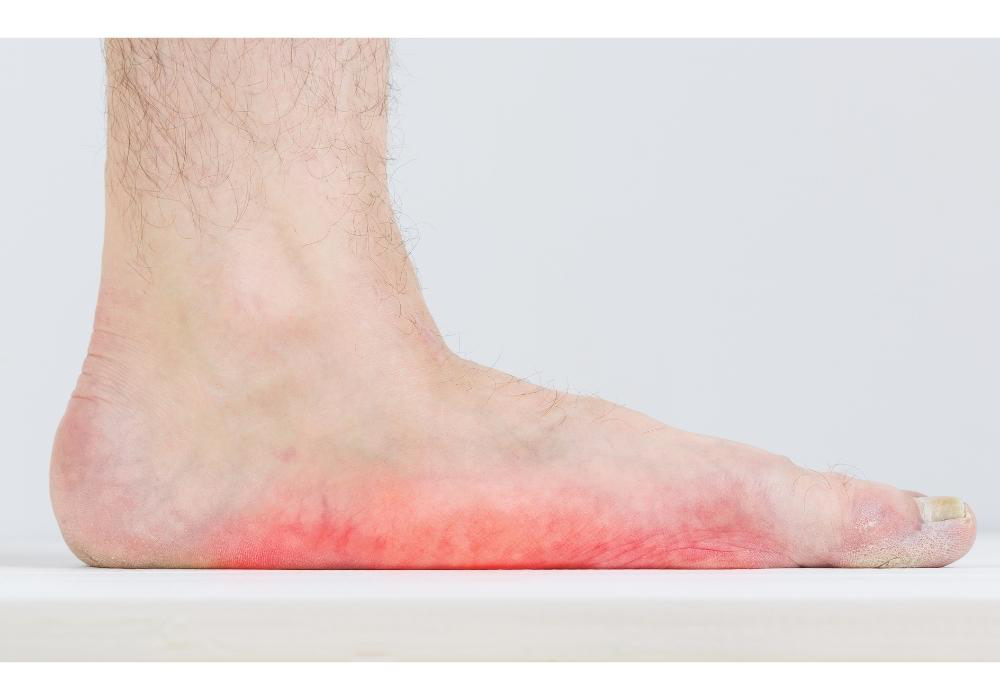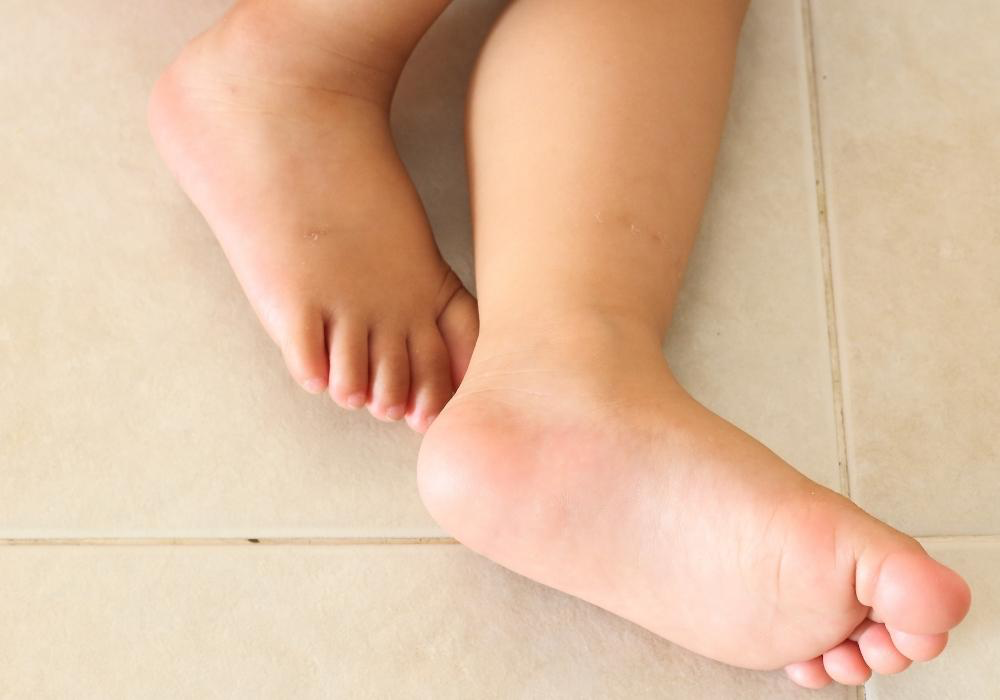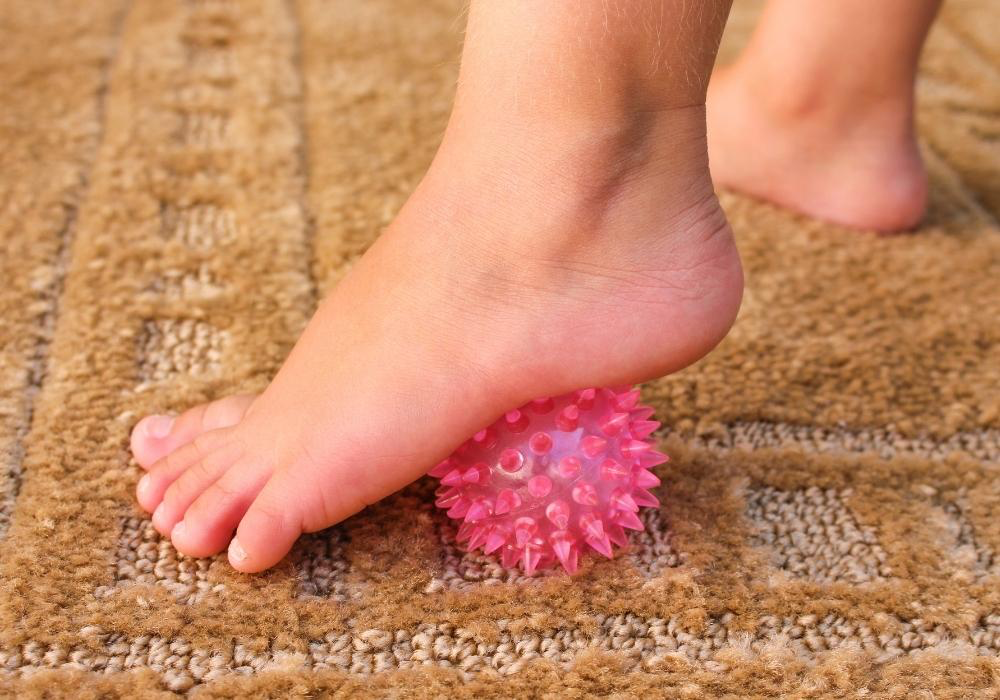How to deal with flat feet?

People with flat feet, commonly referred to as fallen arches or pes planus, have very low or no arch in their feet.
When someone has flat feet, the arch rises slightly off the ground when they stand, leaving a gap beneath the inner half of the foot. Here are some facts concerning flat feet:
- Flat feet can occur in children, but they typically outgrow them.
- Adults who have flat feet typically have a problem that affects their feet on a deeper level.
- The symptoms include discomfort in the feet, legs, and occasionally the back's arch as well as swelling or stiffness.
Only when flat feet are painful, suggest an underlying illness, or cause pain in other parts of the body do they require medical attention.
Some folks appear to have no arch at all or an extremely low arch without ever having any issues. Simple devices and exercises can reduce discomfort when flat feet are the cause of the symptoms.
More information on the causes, signs, and treatment of flat feet may be found in this article.
Flat feet: what are they?
People with flat feet may have one or both feet flat on the ground because they have very low or no arch.
The alignment of the body whether a person is standing, walking, or sprinting might be impacted by flat feet. Therefore, having flat feet can raise your risk of experiencing hip, knee, and ankle pain.

What causes flat feet to form?
33 joints keep 26 distinct bones together in a typical human foot. More than 100 muscles, tendons, and ligaments are also present.
The arches give the step a spring and aid in distributing body weight among the feet and legs. The way a person walks depends on the design of the arches. To be able to adjust to stress and different surfaces, the arches must be both strong and flexible.
When a person walks and stands, their feet may roll to the inner side if they have flat feet. Overpronation is what causes this, and it can also make the feet point outward.
People frequently get flat feet as children. The disease, nevertheless, can also appear in adults. While many individuals with flat feet don't experience any symptoms, some may do so depending on how severe their condition is.
Types of flat feet
There are primarily two categories of flat foot issues:
Flexible flat foot
Children are more frequently affected by this type. The child's foot arch will disappear when they stand. The arch will reappear while standing on tiptoes or sitting down.
Rigid flat foot
Whether or not they are bearing weight on their foot, such as when standing, a person with an inflexible flat foot won't have an arch. Both children and adults can get this illness.
The signs of flat feet
Pain in the feet is the most typical sign of flat feet. Strains on the muscles and ligaments that link them can cause this.
Hip and knee discomfort may be brought on by abnormal forces placed on the joints. If the ankles bend inward, these stressors are probably present.
The following areas of the body are most frequently affected by pain, edema, or stiffness:
- ankle
- calf
- knee
- hip
- lower back
- lower legs
A body's weight being distributed unevenly might also result from flat feet. Further injuries may come from shoes wearing out unevenly or more quickly than usual, particularly on one side, as a result of this. It may be difficult for people to run or walk steadily.
Causes and risks
There are connections between flat feet's causes and risk factors. Some things that put someone at risk for the illness could also make it worse.
The typical dangers include:
- obesity
- pregnancy
- diabetes
- foot injuries
- being young or an older adult with a condition that can affect the tendons
- having family members with an existing problem or developing it
Typical causes include:
- foot or ankle injuries
- stress on the arches of the feet due to excess weight
- arthritis or rheumatoid arthritis
- damage, dysfunction, or rupture of the posterior tibial tendon
nervous system or muscle diseases, such as spina bifida, muscular dystrophy, or cerebral palsy - weak arches, or when a person's foot flattens out on the ground when they stand yet the arch is still apparent when they are sitting
- tarsal coalition, which results in unique foot bone fusion and produces rigid, flat feet
- long-term foot use, which might weaken the posterior tibial tendon in later life, the main structural component of the foot arch
- tendonitis, which is a tear brought on by overuse or other damage to the tendon, can develop in youth, as people age, or following pregnancy
Children's flat feet
Foot arches are typically hardly noticeable in newborns, and it can take some time for them to develop into stable arches. This could take place after the age of five in children with flexible flat feet.
By the time they are 10 years old, the majority of children with flat feet will have conventional arches, therefore having flat feet as a young child does not guarantee that one will always have flat feet.
However, a doctor will frequently need to treat the underlying cause if a child has flat feet as a result of improper bone development or another problem, such as spina bifida.
Adults who have flat feet typically have an underlying medical condition.

Diagnostics
Typically, people with flat feet who don't have any discomfort or other symptoms should not see a doctor.
But anyone showing any of the following signs needs to see a doctor:
- newly developed flat feet
- the feet feeling inflexible, stiff, heavy, and unmanageable
- lower leg or foot pain
- symptoms that do not get better when wearing supportive, comfortable shoes
flatness of one or both feet
The majority of skilled medical practitioners can identify falling arches by looking at the feet and watching the patient walk and stand.
The front and rear of the foot will be examined by the doctor. To allow the doctor to check the structure and functionality of each foot, the patient might need to stand on the tips of their toes.
A doctor will also take the patient's medical history into account. In some circumstances, they might request an electromyogram, X-ray, CT scan, or MRI scan.
Physical exercises
Specific exercises may be suggested by a podiatrist or physical therapist to treat the signs of flat feet or stop them from occurring.
In a 2020 study, researchers discovered that just 8 weeks of foot workouts significantly improved participants' gait and foot alignment.
The following exercises are suggested by the American Academy of Orthopaedic Surgeons to increase foot and ankle strength and flexibility, which may help to alleviate flatfoot problems.
Extending the heel cord
The Achilles tendon will roll inward if it is tight. Stretching the heel cord aims to lengthen the posterior calf muscles and the Achilles tendon.
Stretching the heel cord should be done as follows:
- With one hand at eye level on the wall, face the wall while standing there.
- Position the leg that has to be stretched about a step behind the other leg, and firmly place the heel on the ground.
- Bend the front leg's knee until the back leg starts to feel stretched.
- Maintain the position for 30 seconds, then relax.
- Do it nine more times. It's crucial to maintain a straight back and avoid any arching.
This exercise should be done twice a day.
Ball rolling
You'll need a chair and a golf ball for this activity.

Place your feet firmly on the floor and take a seat on the chair. To stretch the plantar fascia ligament, place the golf ball under the foot and roll it back and forth for two minutes under the arch of the foot.
Treatment
Some individuals with flat feet may naturally position their limbs to avoid symptoms. Usually, those who are symptom-free do not need to be treated. Supportive, properly fitted shoes can help if you have flat feet that are giving you pain. Shoes that are really wide might be comforting.
Children typically do not require treatment for flat feet. They might need to utilize custom-fitted insoles and orthotics if they suffer pain. If the feet roll too far inward, custom-made arch supports may ease pressure on the arch and lessen pain.
Because certain bones do not grow properly in childhood, flat feet that begin at birth may persist throughout adulthood. In some uncommon situations, surgery might be required to separate fused bones.
Adults may also wear foot orthotics, and those suffering from posterior tibial tendonitis may find it helpful to wedge their shoes along the inside edge of their orthotics. This ought to lessen some of the strain the body is putting on the tendon tissue.
However, it's crucial to utilize orthotics under a doctor's supervision because using the incorrect orthotics or utilizing them incorrectly might make symptoms worse.
Nonsteroidal anti-inflammatory medications are another option for pain management. If obesity is a significant cause, a doctor may advise adopting a nutritious diet and engaging in regular exercise to relieve stress on the arches and achieve a healthy body mass index.
An ankle brace may be helpful until the swelling is gone. Some patients may be advised by doctors to relax until their symptoms get better and to stay away from activities that could irritate their foot or feet.
An individual with arthritis or a ruptured tendon may discover that utilizing insoles and taking painkillers together helps lessen their symptoms. Surgery can be required if these fail.
Outlook
Flexible flat feet in children are frequently outgrown in adulthood. The prognosis for someone with an inflexible flat foot or an underlying ailment depends on the exact symptoms they experience and the required medical care.
When a degenerative disease is the reason and the symptoms get worse over time, treatment might be challenging. Where surgery is required, a person's prognosis is typically positive. For some people, exercising can help them feel more optimistic. Yet, having flat feet may also necessitate avoiding high-impact activities.
To identify the best course of treatment for them, a person should speak with a doctor.
Complications
Flat feet may increase symptoms in those who already have other foot, ankle, or lower limb issues.
Here are some examples:
- Achilles tendonitis.
- Ankle or ankles with arthritis
- Foot or feet arthritis
- Bunions
- Hammer toe
- Plantar fasciitis, an inflammation of the foot's ligaments
- Posterior tibial tendinitis
- Shin splints
In conclusion
flat feet happen when a person has a minimal or nonexistent foot arch, frequently leading to walking issues and even pain. Flat feet can have a variety of causes, and not all of them will result in discomfort or other symptoms.
When a condition first appears in a child, it typically disappears as the child becomes older. If there is discomfort or an effect on a person's early life, treatment can be required. Anti-inflammatory drugs and foot orthotics are typically used in this situation. A person may sometimes require surgery.